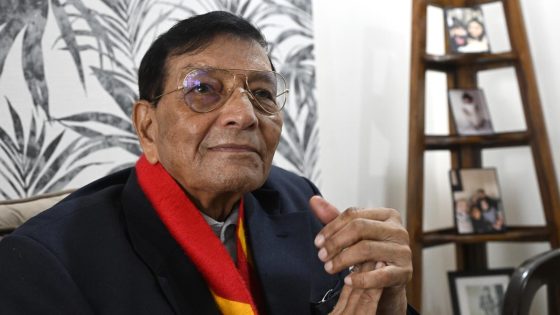It started with pieces of loose cloth crumpled into one. From there, a tennis ball on good days. Making the most of his surroundings inside his small room in Hyderabad, the absence of a football did not stop Syed Nayeemuddin from playing his favourite game – the love for which runs in his blood.
âMy father was a good footballer and came to Hyderabad for his job. I lost him when I was just five years old. I used to go to Remistanpur High School in Musheerabad, where I played with a tennis ball. From there, I played [for] my school in inter-school tournaments,â former India captain and coach Nayeemuddin told Sportstar.
His game caught the eye of the Hyderabad Police Football team scouts. At just 18, Nayeemuddin was called to play for the then heavyweights of Indian football. Initially playing for the reserves, he was gradually integrated into the senior squad and featured in prestigious tournaments like the Durand Cup, Rovers Cup, and IFA Shield. Soon, the heavyweights of Kolkata came knocking.Â
âMohun Bagan, Mohammedan Sporting and especially East Bengal were very interested when they saw me. J.C. Guha (Jyotish Chandra Guha), then general secretary of East Bengal, saw me play in Delhi and decided to pick me (in 1966). Other clubs were also interested, so Jyotish Da sent one of his assistants to Hyderabad so that no club could talk to me. I was under strict surveillance,â Nayeemuddin said, recalling his playing days with the legendary Peter Thangaraj and Ram Bahadur, with whom he used to share living quarters initially.Â
First interaction with âstrictâ Rahim saab
In the present day, Syed Abdul Rahim is an institution in Indian football, being the only Indian coach to win gold in Asian Games history (1951 and 1962). But for Nayeemuddin, Rahim shouldnât only be revered for his work at the highest level but also at the grassroots level, recalling how he visited schools to scout potential talent.
âI was practising inside my high school, and Rahim saab spotted me. He came up to me and said, â Ball upar kyu gaya, neeche kyu nahi aaya?â (Why did the ball go up and not down?) and proceeded to show me where to kick the ball correctly. He was a highly qualified and learned man⦠a perfect coach to guide you on and off the field. He was a strict disciplinarian, almost military discipline, you can say,â Nayeemuddin said.
What ails Indian football?
Cut to the present, Nayeemuddin doubts whether Rahimâs disciplinarian nature would work in the modern framework of Indian football, which has become corporatised. The Asian Games bronze-medal-winning captain feels most players lack the champion mentality and the desire to perform better, which he saw in his peers and seniors during his playing days.
He feels that modern football has made players bigger than the game itself, and it is a common practice for clubs to strong-hand coaches into giving in to player demands, something he has personally experienced during his 37-year-long coaching career.Â
Starting his coaching career with Mohammedan Sporting, he spent three years with the Black Panthers before being appointed as the head coach of the India U17 team and guided the team to the 1985 AFC U-16 Championship qualifiers.
ALSO READ | Hyderabadâs glorious football legacy faces existential threat amid financial turmoil
The following year, he was given the responsibility of managing the senior national team. In 1990, he joined East Bengal, leading the club to its second Triple-crown of Indian football (IFA Shield, Durand Cup, and Rovers Cup). In his three stints with the club, he won eighteen trophies — second-highest behind P.K. Banerjee. After a two-year stint with Mohun Bagan, Nayeemuddin was appointed India coach for the second time in 1997 and led the Blue Tigers to the SAFF Championship in the same year.
He added another in 2005, during his second stint as national team coach. Apart from coaching the three Kolkata giants, Nayeemuddin also managed Mahindra United and Bangladeshi clubs, Brothers Union and Mohammedan SC (Dhaka).Â
âIn my coaching career, I was once asked by a club official — why I was training the players so hard. Humare time mein maidan mein jaane ka time tha, aane ka nahi (During my playing days, there was a fixed time to go to the ground for training, but no fixed time to return). We used to practise till we thought we had got better. Everyone was practising, so you need to do that as well to be better than the others and with sincere effort.Â

Coach Syed Nayeemuddin attending to Bhaichung Bhutia, one of the key players of the Indian team.
| Photo Credit:
K. Gajendran.
Coach Syed Nayeemuddin attending to Bhaichung Bhutia, one of the key players of the Indian team.
| Photo Credit:
K. Gajendran.
âIn my days, players used to do individual practice for more hours due to their self-interest and sacrifice their whole afternoon. They had more attention and [wanted to get better and better]. Back then, every playerâs mentality was to cover all 10 players, including the goalkeeper and support both – in defence and attack,â Nayeemuddin adds.Â
Accepting the inevitability of the sport being driven by money in current times, Nayeemuddin said it is difficult to replicate the grit, passion and determination prevalent in the golden era of Indian football. During his playing days, Nayeemuddin recalled that comfort was secondary to winning, which is not always the case in modern Indian football.
âIn 1970 (Asian Games), when we beat Japan (in the bronze medal match), I remember before the tournament, we used to practise in Bombay at Islamia High School. We used to stay inside the classes and practise on the school grounds. Basha (G.M.H. Basha, India coach from 1970-71, 1975 and 1977) saab was there with us as well.
âFrom there, we went to the Asian Games and beat Japan…even Bechu Da (Manindra Nath Dutta Ray, AIFF President from 1960-1975) and Ziauddin saab (Khalifa Ziauddin, AIFF President from 1980-88) were present, but they never interfered [with the footballing matters],â he said. Â
And it is not the playersâ desire to perform that Nayeemuddin questions but also the collective responsibility of the clubs to improve the standard of Indian football in general. Be it on-pitch decisions like the appointment of coaches or off-field factors like ensuring a good diet, the Arjuna and Dronacharya Award recipient feels that the country needs to change its mentality to be at par with the heavyweights of global football.Â
âMaintaining a good diet is important. When I was a coach, I was with a club [I donât want to name them] â they asked why I was spending 8000 rupees daily for the playersâ tiffin. I wanted the best quality food for my players, and I got the results for that. But the officials used to ask why I was spending so much… this is why Indian football is nowhere,â said the former India coach.Â
Syed Nayeemuddin, former coach and captain of the Indian football team during an interview with Sportstar, in Hyderabad.
| Photo Credit:
RAMAKRISHNA G/ The Hindu
Syed Nayeemuddin, former coach and captain of the Indian football team during an interview with Sportstar, in Hyderabad.
| Photo Credit:
RAMAKRISHNA G/ The Hindu
Focussing on on-pitch decisions like coach appointments, he felt that nowadays, a lot of importance was being given to âdiploma holdersâ, with factors like self-experience and knowledge taking a backseat â âFor people coming to coach from outside India, they are constantly asked about what they require to perform. They are given time if they fail. If an Indian coach fails, they are changed the next day. Indian coaches should be provided with the same facilities, the same freedom and the same time.â
Today, the presence of the beautiful game is scarce in Hyderabad despite the city having a rich legacy in the annals of Indian football history. Nayeemuddin feels that many are opting for other sports, where facilities are better and the chance to earn more money is higher but feels that the present government can revive the sport in Hyderabad.Â
âChief Minister (Revanth Reddy) is very interested [to revive football]. Telangana Football Association president Mohammad Rafath Ali saab and secretary G.P. Palguna are all working hard. The Chief Minister himself was a good footballer. So, they will try, and see that Hyderabad football becomes not only the top in India but maybe in Asia. And I am always here [if needed]. I am ready to groom footballers and teach them techniques and tactics – things which I know.â
Source Agencies




